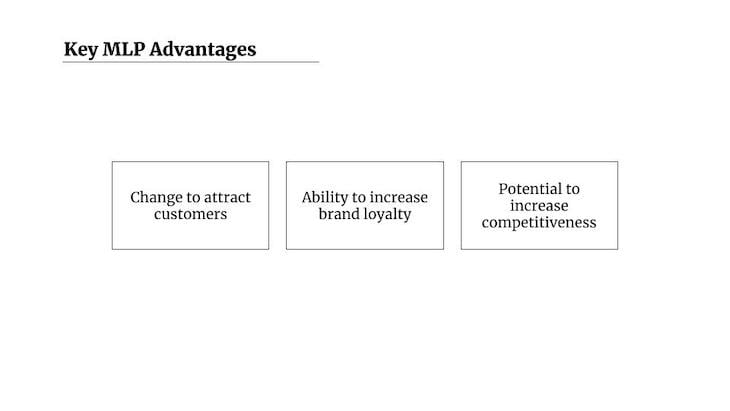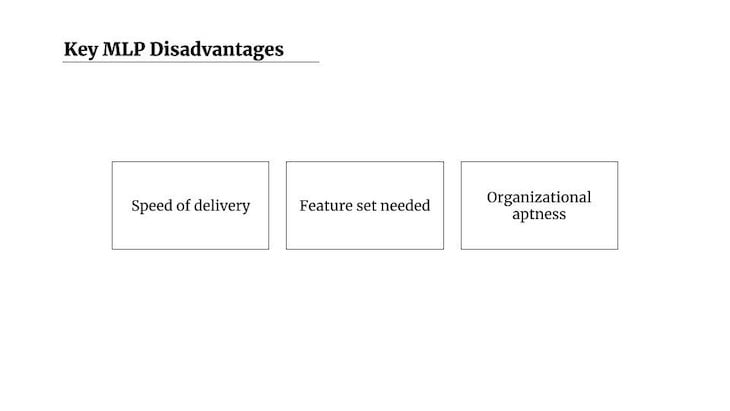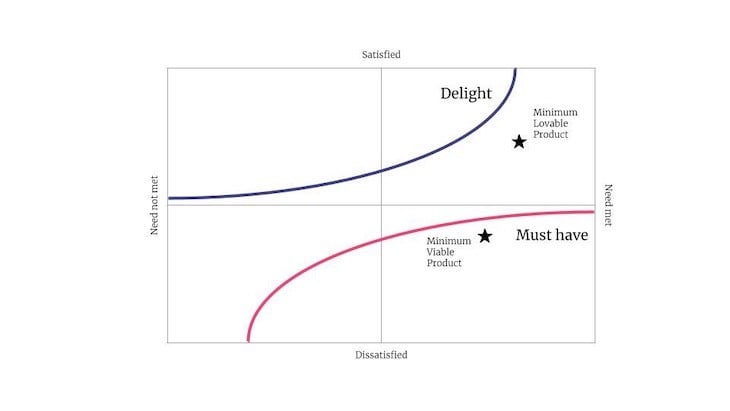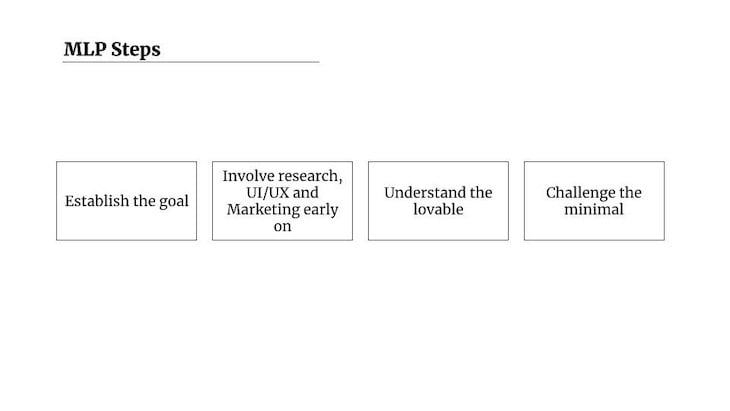Elijah is a product manager at a company specializing in conversational artificial intelligence. Elijah has been around for a while as a product manager and knows all the ins and outs of scoping out minimum viable products (MVPs).

Reflecting on delivery, he realizes the MVPs had varying success, with some having high, low, or even no adoption rates. It confuses him, especially as he has consistently run discovery.
During new user research, when talking to customers about one of the features with a very low adoption rate, some interviewees mention they do not love the MVP — it just does not excite them.
This makes Elijah curious: what if there is something besides the MVP, something more lovable?
The market is consumer-driven. Customers have a variety of options available when looking for a solution to meet their needs. As a result, products compete not only for functionality but for customer satisfaction and appreciation.
In other words, the solution should not only solve the problem but also meet additional customer expectations or even delight them. What Elijah learned in the example at the beginning of this article is that a minimum viable product is not always sufficient.
Customers demand to, at minimum, be presented with a product they can love from the first time they’re introduced to it. This is where the idea of the minimum lovable product (MLP) comes into play.
Before diving into the world of the MLP, it is good to understand an MLP approach has both advantages and disadvantages. Let’s take a moment to look at the three key ones.

When aiming to acquire a bigger piece of a highly competitive market, you need to stand out and sway targeted customers to evaluate your product. The evaluation of your product depends heavily on the emotional connection customers experience when initially introduced to it.
By focusing on the MLP you increase those changes.
A loyal customer is a joy forever. If that is not an existing quote, it should be. Loyal customers are your product advocates who allow you to attract new customers with minimal marketing efforts.
By delivering MLPs instead of MVPs, you increase your chances of moving the beginning users to become regular users and regular users to become loyal customers and champions of your product.
It goes without saying that the MLP approach increases your ability to gain and keep a competitive advantage, but it’s not so much a survival tactic as an expansion tactic. Creating an MLP enables you to stand out, especially when competing in a market with many alternative solutions.

Creating an MLP will take more time. The aim of the MLP is to get customers interested in and hooked on your product. This requires an additional investment in research, UI and UX, and marketing efforts.
Without bringing designers and marketers early to the table, the MLP is almost certain to fail. In addition, the MLP is more development-heavy because there are more building requirements.
Whereas a team building an MVP focuses on delivering value with a minimum number of features, the team wants to ensure that the MVP not only creates value but also wins customers over. In most cases, this will require you to build more features.
Organizations might be resistant to building an MLP. This might be because they have no experience creating them or building a product culture around developing MVPs.
Another factor that might come into play is company size. For example, when teams fail to understand what makes a product lovable, the chances of a good result are slim.
I already slightly touched upon there being an MLP and an MVP (there is even an MMP, which stands for minimum marketable product, but let’s leave that one out of the equation for now ).
The big debate remains which one is best: The MLP or the MVP? Whether you are an optimist or a pessimist, the answer is both or neither. The MVP and MLP have different purposes.
To understand the difference between the MLP and MVP, we need to start with their individual objective.
The MLP aims to introduce features customers will be delighted by, while the MVP aims to introduce features that deliver value and, in a sense, are good enough to be used.
Now let us have a look at what this means using the KANO model. The KANO model is a prioritization model used to rank features based on how likely they are to satisfy the customer.
The x-axis in the model represents how well a need is met, whereas the y-axis represents the potential to satisfy the customer. When you plot the MLP and MVP in the Kano model:

Looking beyond their objectives, there is an additional set of specifications that help clarify the difference between the MLP and MVP, determining which method would best be used.
As shown through the KANO model, the MLP and MVP each have different objectives. The MLP aims to acquire new customers and grow customer loyalty with features they love. The MVP aims to do this by providing usable features.
The MLP is more frequently used in a market where a wide variety of alternatives are available to customers to satisfy their needs. On the other hand, an MVP, though used in the same market condition as the MLP, is more suitable in a market with fewer options available.
When the customer can clearly express and know what they require, an MLP might be more suitable. In cases where the customer is uncertain or unclear of what they want, the MVP might provide a better road to analyze and evaluate the customer’s needs.
Delivering a successful MLP requires additional development effort. Moreover, an MLP is more suitable in an environment where architectural decisions have been made and are stable. For the MVP, efforts are leaner, and the architecture is more fluid, meaning decisions still have to be taken.
The MLP covers a bigger bucket of work, not only in development but also in relation to research, UI and UX, and marketing. More time and effort are required from a bigger group. For the MVP, this effort is significantly reduced.
The MLP investment is a bigger bet involving a larger scope, time, effort, and cost. It requires more stability and, as such, has reduced agility and less flexibility to pivot. The MVP, on the other hand, is a smaller bet, and therefore agility is higher:
| Minimum lovable product | Minimum viable product | |
| Objective | Gain competitive advantages, by introducing features customers love | Incrementally validate, learn, and enrich the product with features customers can use |
| Market | Can be evaluated with many alternatives available | Evaluating the market is harder with fewer alternatives available |
| Customers | Knows exactly what they want | Uncertain or unclear about what they want |
| Development | Dedicated effort in a stable architecture | Flexible effort, with fewer architectural decisions |
| Time and effort | Dedicated effort to the opportunity | Minimal effort |
| Agility | Bigger bet, with lower agility | Smaller bet, with higher agility |
Still interested in creating an MLP? Well, then, this is the moment you have been waiting for.
To create an MLP, follow these steps:

Establish what you want to achieve by answering the “why” question. Instead of tackling the “why” from a user perspective. Have a clear understanding of what you aim to achieve to align all stakeholders and get their buy-in.
Whether you are developing an MLP or an MVP, ensure that what you’re pursuing is going to solve your customer’s pains and provide the sought gains.
Involving research, UI and UX practices, and marketing early on can help you figure out the following:
Answering all these questions can help you evaluate new product features you want to implement.”
It is in the acronym MLP — the “L” in lovable is key. Make sure to include features that delight your customers and make them truly enjoy and fall in love with your product.
Start by looking at the problem space rather than the solution space. Then, include features that evoke an emotional reaction. Those features that evoke an emotional reaction, in general, have a bigger chance of increasing engagement.
If you don’t watch it, your feature can be overengineered quickly. Look for balance and prioritize the elements required in the MLP.
If you leave out too much, you will not achieve success. If you overdo it, you waste valuable time and resources, or even worse, your competitors can beat you to the punch on delivery.
Here are two examples of companies worth mentioning when talking about MLP.
To start with the most obvious example of a successful MLP, let’s take a look at Aha! No, that was not an epiphany. I mean the company Aha! Co-founder and CEO Brian de Haaff was the first one to coin the concept of MLP back in 2013 and popularized it in his 2016 bestselling book, Lovability. Aha!.
If you want to learn more, I recommend reading Haaff’s book or checking out his keynote, Roadmap your way to minimum lovable products.
Customers have many options, so having tons of data on them is key to understanding their every move and what can be done to impress them.
Jiaona Zhang, former product lead at Airbnb and a great advocate of the MLP approach, understood this and found that customers were looking for basic amenities and truly life-enriching, authentic experiences.
To meet these needs, Airbnb launched AirbnbPlus, which features a new search page designed to make users feel like they are finding homes to stay in rather than hotels.
The home tour feature allows customers to photographically go through each room and get a more personal experience as if it were a digital open house. Now, if that isn’t lovable, what is?
With the market becoming more consumer-driven, creating a minimum viable product is not always going to be enough. To make customers use the product from the get-go, they require a minimum lovable product (MLP). Despite its large features set and time-consuming development process, the MLP brings great advantages.
Before deciding on building an MLP, ensure it is the right approach for you to go forward with.
Once a decision is made, keep in mind these the following when building your MLP:
Featured image source: IconScout

LogRocket identifies friction points in the user experience so you can make informed decisions about product and design changes that must happen to hit your goals.
With LogRocket, you can understand the scope of the issues affecting your product and prioritize the changes that need to be made. LogRocket simplifies workflows by allowing Engineering, Product, UX, and Design teams to work from the same data as you, eliminating any confusion about what needs to be done.
Get your teams on the same page — try LogRocket today.

Most teams fail at autonomy. Learn how clear rules help product teams move faster without micromanagement.

A practical framework for PMs to use AI in ideation without sacrificing judgment, strategy, or decision quality.

A practical five minute revenue estimation method to help product managers compare ideas, drop low impact features, and prioritize smarter.

A practical guide for PMs who want to stop being bottlenecks, delegate smarter, and lead teams effectively with a clear ownership framework.